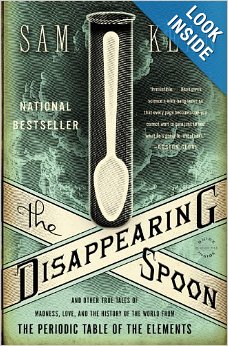I can’t choose just one favorite book. I decided to share 2 books, one for each major content area I currently teach. while I don’t have a unique way of using either book in class, I can say that these books are clear student favorites. Students tell me they’re interesting and informative and help with understanding of important topics. We use each book differently.

The Disappearing Spoon
Chemistry students devour Sam Kean’s The Disappearing Spoon, and Other True Tales of Madness, Love, and the History of the World from the Periodic Table. So often, we forget that the “old dead guys” had lives, loves, families. We forget the historical context of their work – the politics, social norms, It is assigned to incoming Advanced Placement Chemistry students as summer reading. Students report the book helps them make friends with elements; to use element names and properties in everyday thinking, and to build a framework for the descriptive chemistry we do throughout the course. There is great appeal for kids who think of themselves more as historians than scientists. There are several study guides available for use with the book.
Blueprints: Solving the Mystery of Evolution presents the history of our understanding of biological evolution; If you’re a biologist, you know Thomas Dobzhansky (“Nothing in biology makes sense except in the light of evolution.”) If you’re not a biologist and think you understand the modern synthesis of evolutionary theory, you owe it to yourself and your inner educator self’s commitment to lifelong learning to read this book. Helping students understand how natural selection drives biological evolution can be challenging. I choose to let Maitland Edey and Donald Johanson help. Donald Johanson was one of the paleoanthropologists who discovered Lucy. Maitland Edey is a journalist who brings together all the lines of evidence explained by biological evolution in a way that a non-scientist can enjoy and understand. This book unpeels the layers of understanding needed to employ scientific thinking in the understanding of the natural world. When working with students as young as 9th grade, the opening chapters that describe pre-Darwin thoughts on change and fixity in geology and in living things. help us We read later chapters together as we construct our model of the Modern Synthesis. Just read it.
What are your favorite books? Why are they your favorites? How do you use them with students?


These look fascinating. I am so glad you joined the challenge!